![]()
![]()
![]()
Use LEFT and RIGHT arrow keys to navigate between flashcards;
Use UP and DOWN arrow keys to flip the card;
H to show hint;
A reads text to speech;
15 Cards in this Set
- Front
- Back
|
distinguish between voluntary and involuntary movement |

involuntary movement automatic e.g. flexion, withdrawal reflex
voluntary movement conscious control e.g. visually guided reaching movement
movement is usually a mix of these two, along a spectrum |
|
|
skilled movement involves motor learning and memory
what are two types of memory that may be involved in this? |
declarative memory
factual information life events available to consciousness easily formed and forgotten
non-declarative memory
e.g. procedural memory motor skills not available to consciousness less easily formed and forgotten |
|
|
describe two strategies for controlling voluntary movements |
ballistic
pre-programmed movements
movement largely based on a set of pre-programmed instructions
rapid but at the expense of accuracy - little opportunity for compensation or unexpected changes
pursuit or visual feedback movements
motor command continually updated according to sensory feedback
highly accurate as can be modified while in progress, but slow
most movements involve a mixture of both ballistic and feedback strategies |
|
|
picture showing the areas of the neocortex involved in planning and instruction of voluntary movement |
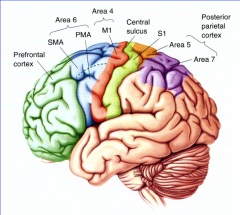
prefrontal cortex decision to make movement
areas 4 and 6 are motor area proper
SMA (area 6) supplementary motor area - important in planning of movement imaging studies showed activity in SMA, M1 and S1 during finger movement task but inly in SMA when the movement is mentally rehearsed (with no movement)
PMA (area 6) pre-motor area
M1 (area 4) primary motor cortex
sensory areas of the cortex are also involved in the control of movement proprioception vision vestibular
S1 - primary somatosensory cortex
Area 5 (posterior parietal cortex)
Area 7 (posterior parietal cortex) |
|
|
picture showing position of the basal ganglia |
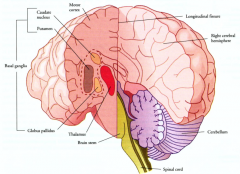
|
|
|
what are the main non-corticol brain structures involved in the control of movement? |
basal ganglia
cerebellum |
|
|
role of the basal ganglia in control of movement
disease processes involving basal ganglia |
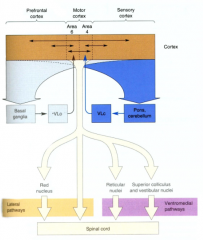
input mainly from prefrontal cortex
output to pre-motor area via the thalamus (VLo and VLc are parts of the thalamus)
function - initiation of movement - putting motor plan into action - planning of complex voluntary movement
Parkinson’s disease
difficulty in initiating movement tremors, hypokinesia, shuffling gait, progressing to general cognitive decline pathology is in the basal ganglia - loss of dopaminergic neurones
treated with DOPA, MAOIs, deep brain stimulation
Huntington’s disease
random involuntary movements
choreas (jerky involuntary movements), difficulty speaking and swallowing, progressing to general cognitive decline
affects basal ganglia |
|
|
role of the cerebellum in control of movement
disease process involving cerebellum |
input mainly from the sensory cortex
output to primary motor cortex via the thalamus
function - coordination and smooth execution of movements - motor learning, error detection
cerebellar ataxia
damage to cerebellum
poor coordination
strong association with depression, anxiety, alcoholism |
|
|
describe the descending pathways for motor control |
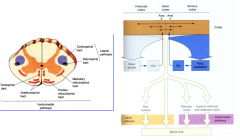
lateral pathways (corticospinal and rubrospinal)
pyramidal neurones in M1 project to the spinal cord (corticospinal tract) and red nucleus (rubrospinal tract)
main function is the control of voluntary movements e.g. distal muscles, fine control of hand
ventromedial pathways
descending systems synapse on motor neurons or one interneurons in the spinal cord
control of posture and balance |
|
|
cheeky wee diagram showing the general principles of organisation of spinal motor circuitry |

IN - interneuron CPG - central pattern generator |
|
|
what type of neurons innervate skeletal muscle? |
α-motoneurons |
|
|
what is a motor unit? |
each motor neuron axon branches to innervate 3 - 100 muscle fibres, the motoneuron and the muscle fibres it innervates are called the motor unit |
|
|
what are motonuclei? |
collections of motoneurons in the ventral horn of the spinal cord are called motonuclei |
|
|
what is the segmental distribution of neurons controlling muscles in different parts of the body? |
* cervical - arms and upper body
* thoracic - trunk * lumber and sacral- legs |
|
|
how can the strength of muscle contraction be graded? |
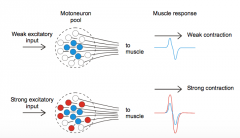
* the strength of muscle contraction can be graded by the recruitment of motoneurons
|

